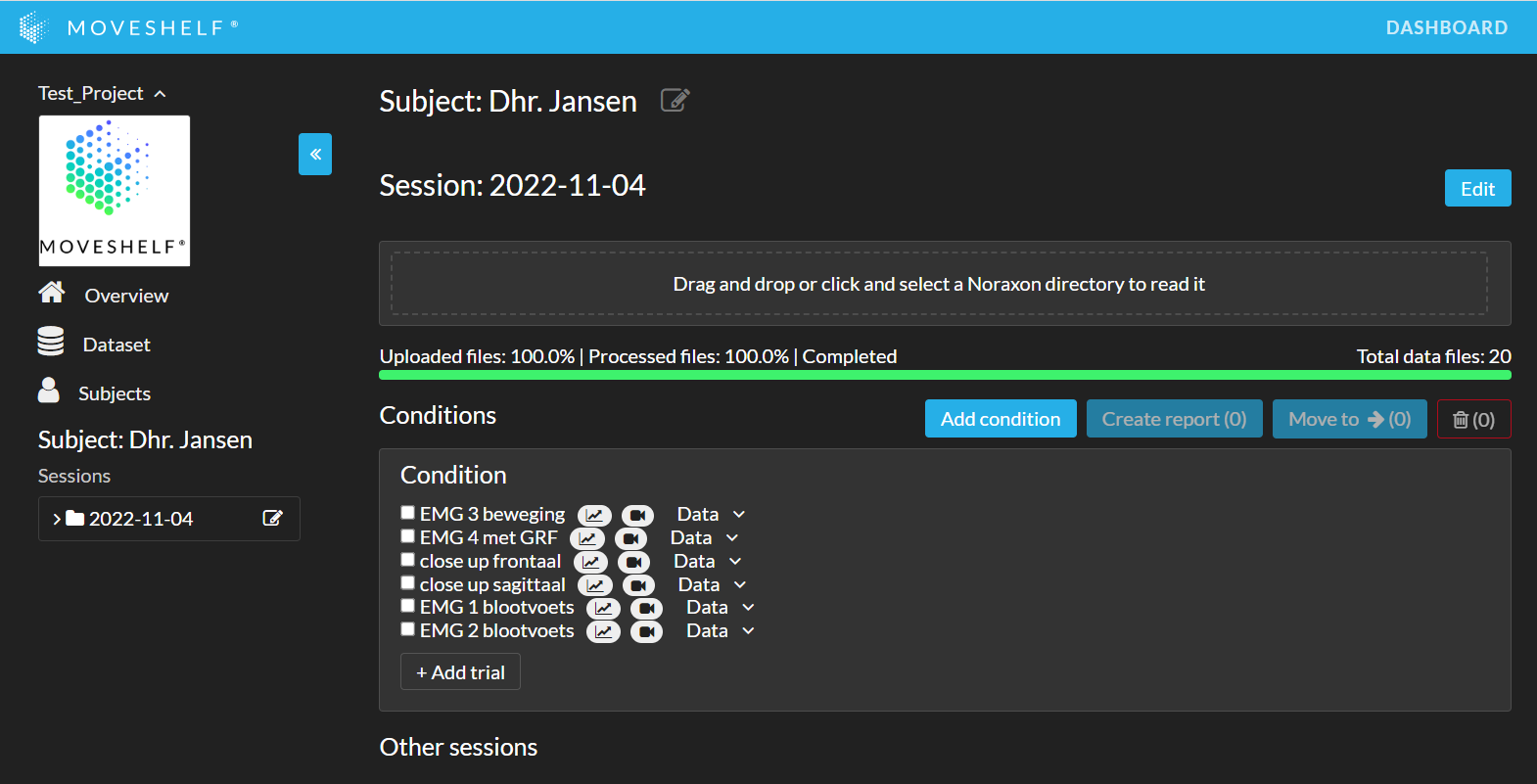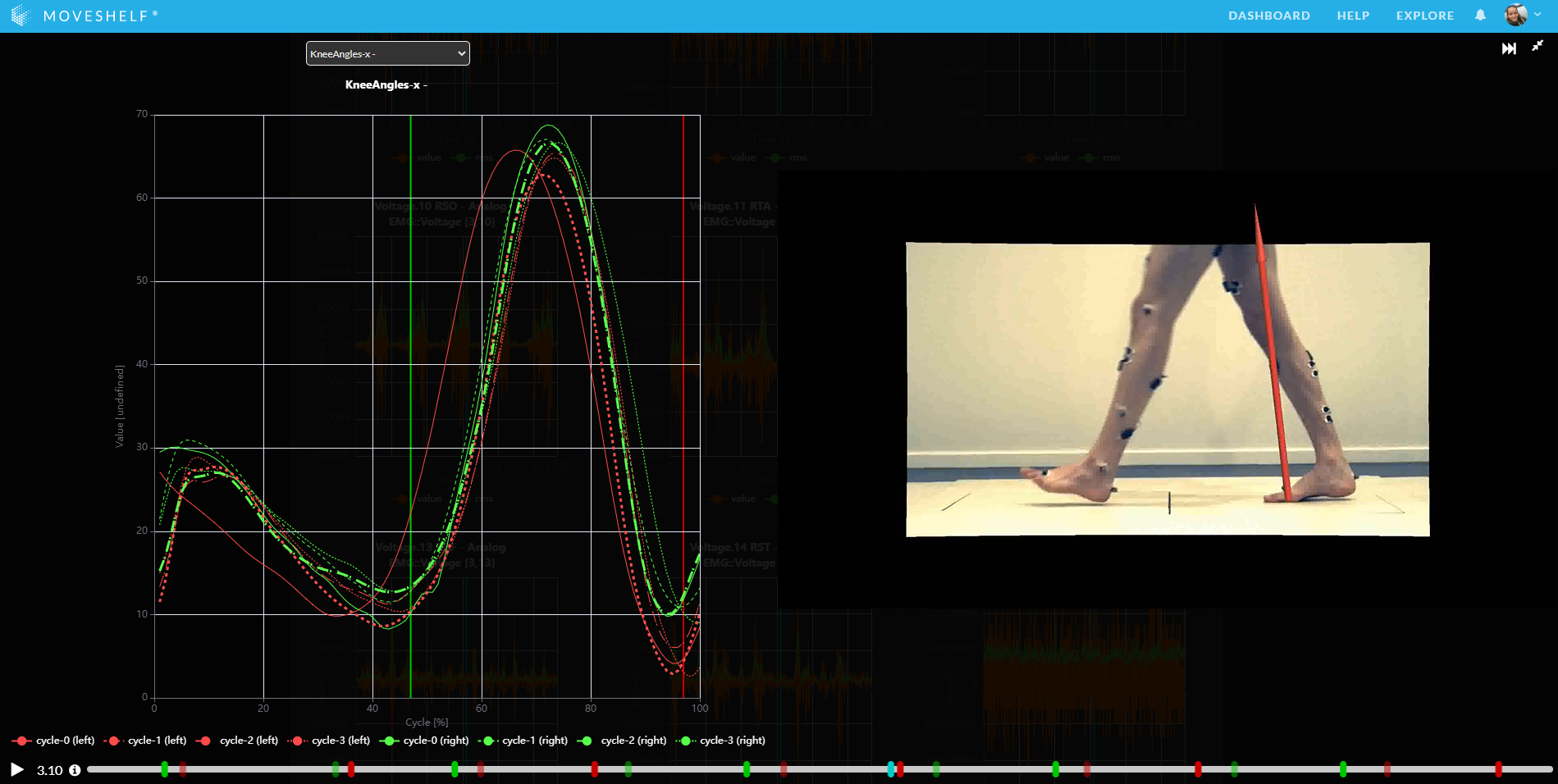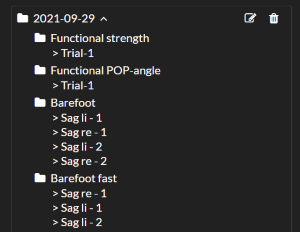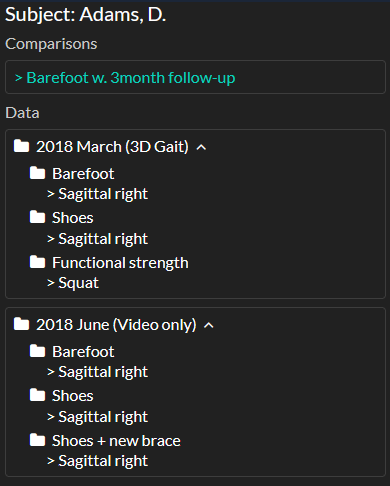Upload and visualize data from Noraxon systems
Moveshelf continuously expands its support for data of different sources and vendors to support the high variety of hardware systems that measure movement. This makes it possible to support healthcare organizations in measuring patients wherever they are and accessing the data wherever clinicians work.
From now on, Moveshelf supports data from Noraxon and its data structure. This means that you can upload a full measurement session at once by uploading one Noraxon directory. These directories contain exported C3D and video files that are generated by Noraxon and can be read by Moveshelf. Moveshelf then automatically places the different measurements into separate trials, which all have synchronized video and interactive graphs of force and EMG data.
On top that, we also expanded our feature that generates ground reaction force vector overlays on video to support Noraxon data as a possible source.

Project templates for trials and comparisons
Each organization in movement analysis is different, and there is no one-size-fits-all solution. That’s why at Moveshelf we support organizations with integrating their specific workflows, measurement technologies and their existing IT infrastructure.
A very specific example of this is that every organization has optimized their data visualization in a way that supports their way of clinical decision making best. For example, each organization has clear preferences regarding the terminology, graph selection and graph representation that works best for them, and what their clinical personnel has become used to over years of analyzing gait.
With our latest update, we are introducing a new feature called Project Templates. With Project Templates it’s possible on Moveshelf to specify these preferences for each different project. Every trial and comparison that you create in your project will then be automatically visualized according to the project template.
You can dictate customized names of the graphs, Y axis labels and movement directions, set Y axis max/min limits, and only show a fixed and standard subset of graphs. This produces a more user friendly interface, filtering out graphs that are not relevant for the users that you provide movement analysis results to. For example, some organizations are interested in both the EMG envelope and the raw EMG, and others prefer to only inspect raw EMG.

Fully synchronized media and graphs, with a playhead
Synchronizing graphs, video and 3D allows you to analyze a graph with the context of the subjects’ exact movement. To indicate the current time of the video/3D, a vertical line is placed in all graphs: we call this a playhead. Depending on the type of graph, either one or two playheads are shown. For bilateral graphs like for those of the knee, there is a red (left) and a green (right) playhead. For one-channel graphs like the trunk, pelvis, force plate and EMG there is one playhead in blue.
To make the synchronization even more clear for graphs where multiple gait cycles are plotted over each other, we highlight the active gait cycle that is playing in the video/3D at that time.

Note: this image shows a graph with two playheads and a video in a maximized window to visualize the playhead feature best. This maximized window we call ‘Split screen’ and helps you to dive into details of multiple aspects of your subjects’ movement patterns at the same time.
Automated integration with third party storage and archives
The Moveshelf application is the bridge between the hardware in your movement lab and your hospital’s IT. We experienced that, aside from national and international regulations, organizations frequently have additional policies on information security, one of which can be the use of one storage system for all hospital data.
![]()
We integrate with these third party archiving systems to automatically receive and store archives with movement data (including common movement analysis and video formats from Vicon, Motek, Contemplas). Our first live third party archive integration is now live, starting with ArQive. At data import, we automatically parse the format into our subject-oriented structure on Moveshelf, organized in sessions and conditions so the lab operators can save time and focus on applying their expertise in interpreting the subject’s movements.
Updated graph visualization for Trials
As we work together with our customers, we learned that they like to view all recorded gait cycles. Graphing the data is one of the most important ways for them to detect deviations in gait patterns. So, we continuously work on improving this visualization and released a new version of graph visualisations.
Clicking the legend of a line below the graph will hide/show that line, so you can really focus on the cycles you want to analyse. Also, hovering over a graph with your mouse gives you the values for all lines at that point of the gait cycle or time. The graphs were already interactive before, but now they look even nicer!
Organize data in conditions
With movement analysis our customers learn to understand all aspects of their patient’s disorder. The movement patterns of patients can differ under a different set of circumstances, which our customers assess through captures in a set of conditions like walking with and without shoes. This structure of grouped trials per condition is maintained on Moveshelf. This allows the lab operator to navigate between trials of different conditions with just one click, as they’re doing their initial investigation of the data.
When a lab operator has decided which trials and reference data they want to show in their comparison on Moveshelf, the condition belonging to a trial is automatically reflected to make the interpretation of the difference in movement patterns as easy as possible.

Single Sign-On for enterprises
People these days are increasingly frustrated with having to remember too many passwords. And enterprise IT departments know that reused passwords are a very common danger threatening the security of logins. That’s why we implement single sign-on for our enterprise customers using Azure Active Directory.
How does this work? When our enterprise customers come to Moveshelf, they are redirected to the login page set up by their own organization. This is the same login that they use to access Microsoft Outlook and other software that the organization uses. This way, users have to remember only one password, and the enterprise can check whether the user should have access to Moveshelf. The enterprise then communicates back to us that yes, the user should have access, without Moveshelf ever having to know the password.
Subject-centered workflow
Movement analysis is centered around measuring subjects. We’ve designed a subject-centered workflow, which can optionally be connected directly to a Electronic Health Record system.
With this subject-centered workflow, it’s easy to see all data from each subject in one place, and to follow the subject longitudinally. In the example below, we have a subject that was measured first for a full 3D gait analysis in one location. In the follow-up, a video-only measurement (from an entirely different location) was deemed sufficient to determine whether the subject had improved after the intervention. With the subject-centered workflow on Moveshelf, it becomes easy to compare data from different locations and different technologies.

Enterprise storage and improved network security robustness
By now you probably know that Moveshelf adopts the highest level of data security. All our services implement state of the art authentication and our underlying infrastructure is fully compliant with GDPR, ISO 27001 and ISO 27017.
What you might not know is that we are very flexible in meeting the storage requirements of our Enterprise customers. To name a few:
- Data of each customer is clearly separated in individual storage ‘buckets’.
- Data is encrypted according to AES-256.
- We can configure our data storage to ensure it’s stored in a defined region, such as within the European Union.
- We work with PACS/VNA providers such as Sectra to store data within the bounds of the hospital, if required by hospital policy.
The maintenance update we did on Moveshelf’s infrastructure on January 5th, 2022 included further security updates for the enterprise:
- We improved networking security to protect Moveshelf’s servers and infrastructure to comply to the latest regulations and a customer’s specific policy.



